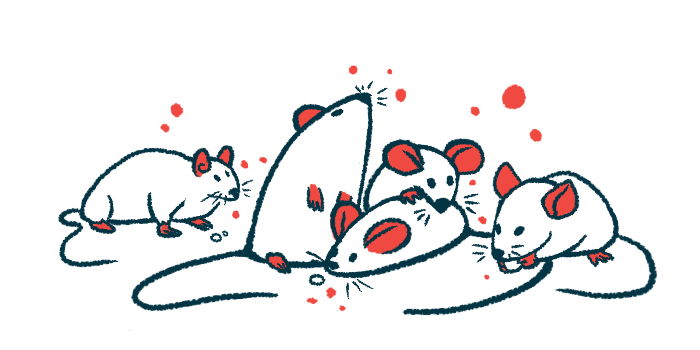Treatment with brilaroxazine found to ease lung scarring in IPF rat model
Reviva's oral therapy improved lung function, prolonged survival
Written by |

Brilaroxazine, Reviva Pharmaceuticals’ experimental therapy for idiopathic pulmonary fibrosis (IPF), was found to reduce lung inflammation and fibrosis, or scarring, in a rat model of the disease.
The treatment also improved lung function and extended survival in the animals, the study showed.
Titled “Evaluation of Brilaroxazine (RP5063) in a Bleomycin-Induced Rodent Model of Idiopathic Pulmonary Fibrosis,” the study was published in the Medical Research Archives. The data also were shared in a poster with the same title at the 2023 American Thoracic Society International Conference, held in May in Washington, D.C.
“The improvement in survival and lung function, coupled with significant reduction in fibrosis and proinflammatory [molecules] in the bleomycin-induced rodent model of IPF reinforces the multifaceted action of brilaroxazine,” Laxminarayan Bhat, PhD, Reviva’s founder, president, and CEO, said in a company press release.
The observed effects of the medicine, which modulates serotonin signaling, provide “proof-of-concept support for the potential of brilaroxazine to treat pulmonary fibrosis and inflammation stemming from underlying dysfunction in serotonin signaling in the lung,” Bhat said.
Brilaroxazine given as preventive and interventional treatment
Brilaroxazine received orphan drug designation in the U.S. for the treatment of IPF and pulmonary arterial hypertension, a condition characterized by higher-than-normal pressure in the arteries that carry blood from the heart to the lungs. The company had announced, in late 2021, its plans to file a request to begin Phase 2 clinical trials in people with lung disease.
IPF occurs when scar-like tissue builds up in the lungs for reasons that are not known. Over time, the resulting lung scarring can get worse and breathing can become harder. The lungs usually become inflamed and stop working as well as they should.
While serotonin is known best as a neurotransmitter, or a molecule key for nerve cell communication, it also acts as a vasoconstrictor, or a substance that causes blood vessels to become narrower. Its receptor proteins, 5-HT2A, 5-HT2B, and 5-HT7, are present in high amounts in the lungs, where they help serotonin act on the blood vessels of the lungs.
Earlier work showed that high levels of serotonin, also known as 5-HT, worsened lung fibrosis in a mouse model of IPF, suggesting a potential role in lung fibrosis.
An oral medicine, brilaroxazine is designed to bind to the many serotonin receptor proteins. Because each of these receptor proteins is responsible for different functions, brilaroxazine is expected to ease the symptoms of IPF by acting on several fronts.
Now, researchers at Reviva and IPS Therapeutique, in Canada, set out to assess the efficacy of 15 milligrams of brilaroxazine, given by mouth directly into the stomach twice daily, in a rat model of induced IPF.
The model was created by administering a chemical called bleomycin to healthy rats to induce damage to the lungs and mimic the symptoms of IPF usually seen in patients.
After being given bleomycin, rats were divided into three groups. One group received brilaroxazine for 20 days as a preventive treatment, while another received a placebo for 10 days followed by brilaroxazine for an additional 10 days as an interventional treatment. The last group received a placebo for 20 days.
Another group of rats were given a sham solution instead of bleomycin and were used as a control group.
While all the rats in the control group remained alive at day 21, only 62% of those given a placebo survived to day 21. However, higher survival rates, at about 90%, were observed in the two groups of animals treated with brilaroxazine. These data indicated that brilaroxazine extended survival in the IPF rat model.
Preventive brilaroxazine treatment also was shown to significantly reduce bleomycin-induced weight loss, improve cardiovascular health, and normalize blood oxygen levels relative to a placebo.
Respiratory resistance, which refers to resistance to air flow in the lungs, was significantly increased in the rat model of IPF relative to the control group. In contrast, rats given brilaroxazine for 20 days showed a significantly lower respiratory resistance compared with those given a placebo.
Researchers call new findings ‘exceptionally encouraging’
Other observations supporting the therapy’s anti-fibrotic effects included a significant drop in the lung levels of hydroxyproline, a marker of lung scarring, and significantly lower Ashcroft scores and Masson’s trichrome staining scores, which reflect lung fibrosis, in rats given preventive treatment.
This group of rats also showed a significant reduction in signs of lung inflammation and liquid accumulation.
Moreover, brilaroxazine treatment was found to bring about a significant drop in the lung levels of two pro-inflammatory molecules, IP10 and RANTES, while a significant reduction in another such molecule, MCP-1, was seen only with preventive treatment.
Effects of interventional treatment with brilaroxazine were generally milder than those seen with the preventive treatment.
The overall effect is exceptionally encouraging and indicative that brilaroxazine is a potentially efficacious therapy for the treatment of IPF.
Taken together, the functional improvements observed with preventive brilaroxazine treatment “might be related to the pleiotropic or combined effect of brilaroxazine on the [disease-causing] factors contributing to inflammation, fibrosis and its proliferation in the lungs,” the researchers wrote.
“The overall effect is exceptionally encouraging and indicative that brilaroxazine is a potentially efficacious therapy for the treatment of IPF,” they added.








